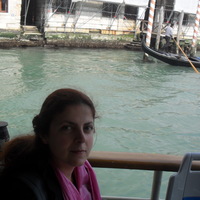
Giovanna Rech
I am a fixed-term researcher in Sociology at the Department of Philosophy, Sociology, Education and Applied Psychology at the University of Padova.
As a sociologist of religion, I am interested in the growing religious pluralism and diversity, considering the complex relationship between religion and collective memory and the role of religious symbols in the European public sphere.
My current qualitative studies reflect three main lines of research: sociological issues to freedom of religion and public dynamics of interreligious dialogue; culturalisation of religion and its consequences on individual and collective behaviors; heritagisation as a productive process of change and innovation within religions.
As a sociologist of religion, I am interested in the growing religious pluralism and diversity, considering the complex relationship between religion and collective memory and the role of religious symbols in the European public sphere.
My current qualitative studies reflect three main lines of research: sociological issues to freedom of religion and public dynamics of interreligious dialogue; culturalisation of religion and its consequences on individual and collective behaviors; heritagisation as a productive process of change and innovation within religions.
less
Related Authors
Noel B. Salazar
KU Leuven
Armando Salvatore
McGill University
Laurajane Smith
The Australian National University
Michaela Valente
Università degli Studi "La Sapienza" di Roma
Amanda J. Lucia
University of California, Riverside
Neena Mahadev
Yale-NUS College
Neil Silberman
University of Massachusetts Amherst
Carole Cusack
The University of Sydney
Karl Baier
University of Vienna
Rodney Harrison
University College London










Uploads
Papers by Giovanna Rech
In the field of Critical Heritage Studies, there is a lack of scientific literature specifically focused on European contemporary religions, denominations, religious confessions, and spiritual communities. Starting from the (in)visibility tactics, this contribution aims to compare two sacred places belonging to new religions in Italy and France, as well as the controversial events they were involved in. These events include the opening and construction of the Temples of Humankind in Damanhur (Italy) and the destruction of the statue of the Cosmoplanetary Messiah at the Holy City of the Mandarom (France), respectively. The interpretative hypothesis concerns the cultural pluralism and religious freedom experienced by new religions in these two European nations. Labeled as sects and objects of social and media disrepute campaigns, the new religions have created a legacy that attracts numerous tourists, visitors, and spiritual seekers from around the world.
This sociological survey focused on the religiosity of the Italians, using a typical survey tool lead to the telematic administration of 913 questionnaires (CAWI) on a non-probabilistic and self-selected sample of people among the 18 and 75 years old, spread through various mailing networks, word of mouth and social media: the channels worked partially like a snowball.
The data collected are significant in describing a sample of “convinced” (here analysed) Catholics who found themselves living a personal and private religiosity in a hybrid environment between the ether and their own home. They mobilized their faith as a social resource, manifesting freedom of expression through social networks.
The uniqueness of the landscape is represented in the case study from different points of view: in literature, in the media and especially in the "tourist's gaze", understood as a co-construction involving guests and the local community in the discovery of the wine-growing cultural landscape, a world heritage site according to UNESCO, and a literary landscape that has been deposited in many literary works. Under the lens of cultural sociology, the process of enhancing intangible resources and the role of creativity that the area is demonstrating in dealing with the consequences of two years of pandemic will be discussed.
The present chapter aims to investigate the modes and means transmitting immaterial meanings of religious and spiritual heritage. In particular, I investigate how the interpretation and mediation of this place of worship take place in the encounters between a Damanhurian and a
non-Damanhurian. Also under investigation is how such a sacred place opposes or participates in the complex phenomenon of heritagisation (or
heritage-making) in the religious and spiritual sector, as the Temples of Humankind are at the same time a sacred space, an outer social place and an attraction for spiritual seekers.
In the field of Critical Heritage Studies, there is a lack of scientific literature specifically focused on European contemporary religions, denominations, religious confessions, and spiritual communities. Starting from the (in)visibility tactics, this contribution aims to compare two sacred places belonging to new religions in Italy and France, as well as the controversial events they were involved in. These events include the opening and construction of the Temples of Humankind in Damanhur (Italy) and the destruction of the statue of the Cosmoplanetary Messiah at the Holy City of the Mandarom (France), respectively. The interpretative hypothesis concerns the cultural pluralism and religious freedom experienced by new religions in these two European nations. Labeled as sects and objects of social and media disrepute campaigns, the new religions have created a legacy that attracts numerous tourists, visitors, and spiritual seekers from around the world.
This sociological survey focused on the religiosity of the Italians, using a typical survey tool lead to the telematic administration of 913 questionnaires (CAWI) on a non-probabilistic and self-selected sample of people among the 18 and 75 years old, spread through various mailing networks, word of mouth and social media: the channels worked partially like a snowball.
The data collected are significant in describing a sample of “convinced” (here analysed) Catholics who found themselves living a personal and private religiosity in a hybrid environment between the ether and their own home. They mobilized their faith as a social resource, manifesting freedom of expression through social networks.
The uniqueness of the landscape is represented in the case study from different points of view: in literature, in the media and especially in the "tourist's gaze", understood as a co-construction involving guests and the local community in the discovery of the wine-growing cultural landscape, a world heritage site according to UNESCO, and a literary landscape that has been deposited in many literary works. Under the lens of cultural sociology, the process of enhancing intangible resources and the role of creativity that the area is demonstrating in dealing with the consequences of two years of pandemic will be discussed.
The present chapter aims to investigate the modes and means transmitting immaterial meanings of religious and spiritual heritage. In particular, I investigate how the interpretation and mediation of this place of worship take place in the encounters between a Damanhurian and a
non-Damanhurian. Also under investigation is how such a sacred place opposes or participates in the complex phenomenon of heritagisation (or
heritage-making) in the religious and spiritual sector, as the Temples of Humankind are at the same time a sacred space, an outer social place and an attraction for spiritual seekers.
Nel suo insieme (il paesaggio) come nelle sue parti ovvero i suoi prodotti (enogastronomici) e i singoli punti di attrazione (i beni culturali tangibili, ma anche le innumerevoli installazioni artistiche) quest’area è diventata un paesaggio e una destinazione turistica “digitale”. È lo sguardo del turista (Urry & Larsen, 2011) che interagisce con quello del residente a catturare la destinazione turistica attraverso la cornice visuale della fotografia digitale (Robinson & Picard, 2009) e della riproduzione digitale attraverso i social media, in primis Instagram (Smith, 2019; van Driel & Dumitrica, 2021).
La valorizzazione delle eredità letterarie (in particolare con il Centenario dalla nascita di Beppe Fenoglio, appena inaugurato) rappresenta dunque una sfida non solo sotto il profilo della patrimonializzazione della letteratura (Jenkins & Lund, 2019), ma anche della sua mediazione attraverso la promozione turistica dove prevale una canalizzazione sul piano della messa in visibilità di contenuti immateriali, quali le opere letterarie.
The analysis emerging from our research revealed a specific panorama: voluntary work and associations probe the individual-institution space through voluntary membership and a commitment that go from activism to the passion of the amateur. However, these activities also question the sustainability as well as the economic and social limits of the transmission of religious heritage in a secularised and increasingly ‘not educated’ context. Here, providing a feasible framework for the reuse of heritage and the respectful exploitation of the significance religious heritage has for a religious community that values worship is imperative.